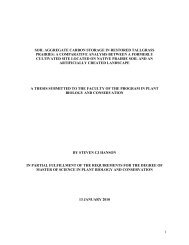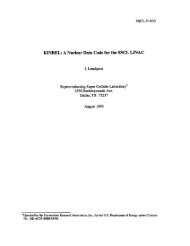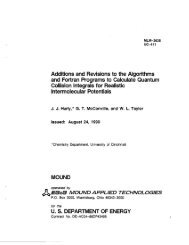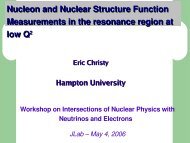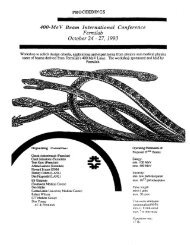Workbook
Workbook
Workbook
You also want an ePaper? Increase the reach of your titles
YUMPU automatically turns print PDFs into web optimized ePapers that Google loves.
137<br />
E-815 (Bernstein / Shaevitz) Precision Measurements ofNeutrino Neutral<br />
CmTent Interactions Using a Sign-SelectedBeam<br />
Adelphi, Cincinnati, Columbia, Fermilab,<br />
Kansas State, Oregon, Rochester, Xavier<br />
IStatus: No Data YetI<br />
A major physics goal of the 1990's will be precision tests of the<br />
electroweak sector of the Standard Model. The Standard Model makes definite<br />
predictions which can be confirmed or refuted with sufficiently precise<br />
measurements. Comparing the value of sin 2 9w measured in e+e- collisions at<br />
the ZO pole, at hadron colliders, and in deep-inelastic neutrino-nucleon<br />
scattering tests the radiative corrections to the Standard Model and allows us<br />
to search for physics beyond it.<br />
E-815 (NuTeV) will exploit the full power of the high-energy, highintensity<br />
Tevatron neutrino beam to significantly improve the precision of the<br />
measurements of the electroweak parameters. The new sign-selected beam<br />
will enable us to measure neutrino and anti-neutrino interactions separately.<br />
This has two significant advantages: (1) previously limiting systematic errors<br />
can be eliminated or reduced, and (2) sign-selection will provide the first<br />
precision measurement of p. The value of p, the ratio of neutral-to-charged<br />
current coupling strengths, reflects the structure of the Higgs sector so a<br />
precise determination of p is a powerful probe of the nature of electroweak<br />
unification. Furthermore, both p and sin 29w are radiatively corrected by mt in<br />
a known way. Hence before the discovery of the top quark, the electroweak<br />
measurements can predict its mass; after mt has been directly measured,<br />
requiring consistency between the predicted and measured values is a<br />
stringent test ofthe Standard Model.<br />
NuTeV will yield a measurement of (1) sin 29w with an expected error of<br />
o(sin 29w) = ±0.0025 (statistical and systematic errors combined), and (2) p with<br />
an error of ±0.0054, a factor of six improvement over existing data. These<br />
errors can be compared to measurements of mt or Mw; the corresponding<br />
error on mt is 30 GeV/c 2 and only 130 MeV/c 2 on Mw, competitive with the<br />
expectations from the collider measurements. The vN measurements have a<br />
unique dependence on the radiative corrections and are the only<br />
measurements which directly determine both sin 29w and p.<br />
Neutrino-nucleon scattering has always been a rich source of<br />
information on the structure of nucleons and tests of QeD and NuTeV will<br />
build on that tradition. We will use our experience from E-744/E-770 to reduce<br />
the systematic errors on as and AQCD through the use of an extensive test beam<br />
program for calibrating the apparatus. E-744/E-770 has already provided the<br />
best measurement of as(Mz); NuTeV can reduce that error by nearly a factor of<br />
two. In addition, the sign-selected beam will allow us to make more precise



